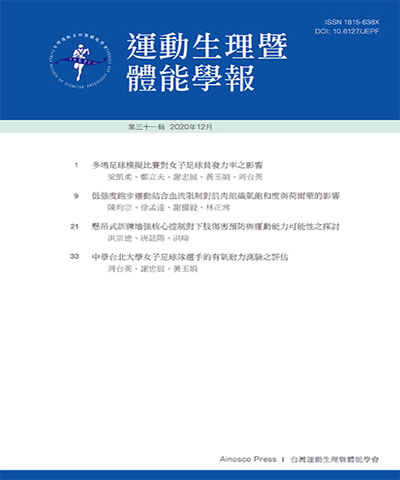
運動生理暨體能學報/Journal of Exercise Physiology and Fitness
台灣運動生理暨體能學會 & Ainosco Press,正常發行
選擇卷期
- 期刊
適當的身體活動可提升國民的體適能狀況,並進而減少許多慢性病的罹患機率,對於提升國民健康、降低醫療支出與社會成本都有極大的幫助,因此,歐美各先進國家近年來紛紛訂定提升國民運動習慣的政策,並陸續進行大規模的體適能檢測與身體活動量分析,以追蹤這些政策的成效。本研究透過網站與Medline、SportDiscus、STICNET資料庫,以及國家圖書館館藏系統,收集與分析世界衛生組織和世界各先進國家的體適能檢測方式、體適能政策及相關指標,並與我國現況互相比較,發展適合我國之體適能指標。本研究的結果顯示,當前我國最重要的課題應在於提升運動人口,培養國民運動習慣,最重要的體適能指標應為身體活動量,包括參與運動的時間和強度;增加身體活動量可降低各種慢性病罹患機率,每年的體適能檢測應以調查民眾身體活動量為主,並包含社會經濟地位與參與身體活動的限制因素等資料,以作為制定政策的參考。本研究參考各國體適能政策,並根據我國現狀,提出以身體活動量為主的2015無中程體適能指標,以及以降低慢性病死亡率為主的2025年長程體適能指標。
- 期刊
本文旨在闡述腦源性神經營養因數的研究進展及其與運動的關連性。BDNF是從豬腦中分離出來的神經生長因素(Neuro Growth Factors, NGF)之一,在氨基酸水平上具有50%-60%的同源性。神經元內BDNF主要定位於細胞體和軸突。免疫學發現中樞神經系統及周圍神經系統的多種神經元及神經膠質細胞都有BDNFmRNA和蛋白質的出現,研究證實,BDNF在中樞神經系統發育過程中能夠促進神經細胞生長、發育、存活、分化和功能表達,同時也能維持成熟中樞神經系統神經元的正常功能。對學習記憶、保護神經元、抑制細胞凋亡、調節神經元內基因表達,以及抵抗長期大運動量訓練導致的神經元損傷,具有程度上的效果。雖然運動與神經營養因數的關係研究尚未引起史多人的注視,但隨著對BDNF基因表達及調控機制研究的深入,及生理功能的進一步闡明,必將對神經系統發育的研究和神經系統疾病的治療以及運動技能形成機制的揭示帶來新的希望和廣闊的前景。
- 期刊
從事單一回合不熟悉的運動-特別是離心運動-之後,通常都會引起很明顯的肌肉損傷之現象。這種離心收縮與等長和向心收縮的特性是不太一樣的,因為在進行離心運動時,其所能動員參與肌肉收縮的神經運動單位數目,遠比其他型態的收縮來得少,故離心運動比其他型態的運動較容易引起肌纖維細微損傷的現象。而離心收縮時所產生的高張力、低神經激活的特性,會產生相當大的壓力作用於受到動員參與收縮的肌纖維之運動單位上,故進而會使其肌肉功能和損傷的評估指標(例如肌力、動力、超音波影像…)引起急性和長期性的變化。雖然已有很多理論被提出來解釋肌肉損傷的機轉,但其真正的機轉至今仍還不完全被瞭解。因此,本文擬針對離心運動的特性、離心運動引起肌肉損傷的可能機轉以及離心運動對引起肌肉損傷和功能的評估指標之變化等三個部分,進行相關文獻的探討與分析。最後,希望透過本文的分析和介紹,能提供一些有用的資訊給運動教練、選手和運動愛好者參考。
- 期刊
運動可增加能源消耗,這個一般性的概念使得早期學者用來推測,運動抑制肥胖的機轉可能與燃燒脂肪組織三酸甘油脂有關。然而,運動過程身體燃燒的主要能源為醣類而非脂肪。高強度運動下,身體脂肪組織所儲存的三酸甘油酯並未增加消耗。雖然運動後24小時身體休息代謝率(RMR)明顯提昇,但三酸甘油酯燃燒總量卻未因此提昇。這些證據顯示「運動燃燒脂肪」這個理論很難解釋運動抑制肥胖的實際結果。事實上,脂肪細胞對能源的吸收能力(包括醣類與脂肪)對於肥胖具有決定性的影響。目前研究發現運動明顯抑制脂肪細胞能源吸收。這個效果主要來自於兩大因素:(一)運動的肌肉組織(身體最主要的組織)對於能源的競爭力提高;(二)運動使脂肪組織對於能源的吸收能力暫時下降。因此,研究常發現規律運動對於身體組成的改變較多,造成體重的下降未必非常明顯-「塑身效果高於減重效果」。運動改變飯後能源分配的效果與「運動強度」及「持續時間」有關,然而其效應的持續力並不長。因此,規律運動的「頻率」對於防止肥胖為運動處方內容的另一個關鍵要素。
- 期刊
The purpose of this study was to investigate the effect of a 24 hours ultra marathon race on runner's kidney function and kidney damage. Eleven participants were recruited, with mean age of 45.1±8.77 yr, height of 166.8±6.23 cm and weight of 60.6±6.96 kg, in the 2002 International 24h Race IAU Asia 24-Hour Championship. Blood and urine samples were obtained from participants before the event, at the end of the event, after 48 hours, and 9 days to find the changes in kidney function. The results showed that runner's blood urea nitrogen (BUN), creatinine (CRE) and uric acid (UA) in blood increased, especially BUN and CRE, the specific gravity, pH, albuminuria (PRO), occult blood and ketone bodies in urine changed, but urobilinogen (URO), bilirubin (BIL), glucose did not change significantly. According to results, we found kidney damage occurred at the end of race because the decomposition of protein and amino acid and filtration and reabsorprtion of creatine, nitrogenous base, albumin, red blood cell and ketone bodies in kidney were abnormal. But 48 hr after the race, every parameters in blood reached the normal consistence range and almost reactions in urine became negative. 9 days after the race, all of the parameters in blood and reactions in urine recovered to original level before the race. We found the runner's kidney working normally again 48 hr after the race and 9 days after the race, there was no difference of kidney function between now and before the race. According the results conclude that 24 hours after ultra marathon race, the runners got kidney damage impermanently, 48 hr after race, they could recover to original lever before the race.
- 期刊
本研究目的在探討以非最大運動攝氧量與心跳率所推算的臨界速度(critical velocity, CV)與傳統運動至衰竭所推算之CV是否有差異存在;並以此強度持續運動30分鐘,進行氧攝氧量、心跳率與積分肌電圖等人體生理反應的變化情形分析,以便確認非最大運動攝氧量及心跳率推算CV方法之有效性。本研究以20名經常參與運動的男性大學生(20.45±0.83歲、177.30±6.21公分、71.62±6.45公斤)為受試對象,受試者除了先接受一次最大攝氧量及最大心跳率測驗以外,所有受試者皆需接受四個不同強度跑步的CV測量。進行CV測量時,同時蒐集受試者之攝氧量與心跳率,以利從各強度跑步至90%、80%和70%目標攝氧量與心跳率之時間推算非最大運動攝氧量與心跳率CV。結果發現以傳統最大努力跑步至衰竭時間所推算的CV(3.54±0.318m/s)與CV(下標 90%VO2max)、CV(下標 80%VO2max)與CV(下標 90%HRmax)(3.64±0.387、3.56±0.410和3.60±0.354m/s)無顯著差異。同時,本研究以實用性較高及估計標準差最低之CV(下標 90% HRmax)持續30分鐘運動時,心跳率會隨著運動時間的增加而上升,RMS下降、攝氧量與MPF則無顯著變化,顯示以此強度運動30分鐘,並無疲勞現象發生。
- 期刊
目的:探討八週不同強度跑步訓練對B型肝炎帶原者肝功能之影響。方法:受試者為30名自願參與本研究之男性B型肝炎帶原者,隨機分配於三組,包括:一、高強度跑步訓練組(HG組;22.5±3.58歲):85% VO(下標 2max),20分鐘;二、低強度跑步訓練組(LG組;22.1±2.77歲):50%VO(下標 2max),30分鐘;三、控制組(CG組;24.4±4.48歲),進行八週,每週三次的訓練。於訓練前(T1)、訓練四週(T2)、八週(T3)及停止訓練四週後(T4)授採血以分析肝功能。研究所得之肝功能檢驗值以正常人值作為判定標準。結果:三個不同運動訓練組,在T1、T2、T3、及T4所測得的肝功能檢驗值皆落在正常範圍內。結論:B型肝炎帶原者經過八週,每週三次85% VO(下標2max) 以及50%VO(下標 2max) 跑步訓練,對肝功能並無不良影響。
- 期刊
Purpose: The purpose of this study was to compare the effects between high (32%) and normal (21%) oxygen on blood lactate (BL), blood glucose (BG), and arterial oxygen saturation (SaO2) after intense exercise. Methods: Twelve males (age=22.66 ± 1.92 years, height=176.50±4.94 cm, and body weight=73.83±7.48kg) were randomly divided into two groups. The experimental group received 32% oxygen and the control group received 20% oxygen. Blood samples were taken after subjects had performed continued volleyball spike 25 times. The BL and BG were tested on the samples taken at 3, 5, 7, 10, 15, 30 and 60 minutes after the exercise and the SaO2 was monitored right after the exercise and every minute in the first 10 minutes after that. Data were compared between these 2 groups by independent t-test. Result: The BL was not statistically different between two groups. The SaO2 was higher in the experimental group than in the control group at the 4th to 5th minute after exercise. The BG was lower in the experimental group than in the control group at 15 and 60 minutes after exercise. Conclusion: This study suggested that high concentration oxygen would probably increase arterial oxygen saturation and recover BG after intense exercise. The effect of high concentration oxygen on removing BL was not clear, at least during the first hours after exercise. More studies with larger sample size are recommended.
- 期刊
Purpose: The purpose of the present study was to investigate the effects of long-term Tai Chi exercise on balance in the old population. Methods: Nineteen healthy old people (mean age 58.57±7.41 years, mean height 164.18±4.25 cm, mean weight 65.83±9.92 kg) who practiced Tai Chi were recruited as the Tai Chi group. They had practiced Tai Chi for 14.22±7.27 years, about 5.50±1.50 days per week, 1.44±0.62 hours a day. Nineteen sedentary subjects matched for age and body size (mean age 55.41±5.87 years, mean height 165.05±5.44 cm, mean weight 65.13±11.04 kg) were recruited as the control group. Data were collected on the 10 meter walk in a straight line test, one-leg standing balance with eyes opened and eyes closed (OLSB), for both groups. An independent t test was used to compare the differences between the two groups. RESULTS: Static balance ability differed significantly between the two groups (p<.05). OLSB of the Tai Chi group was significantly better than those of the control group. For the 10 meter walk in a straight line test, no significant difference was found between the two groups (p>.05). CONCLUSION: The results of this study only confirm that Tai Chi can be a good choice of exercise to improve static balance for the elderly people.
- 期刊
The purpose of this study was to investigate the effect of badminton exercise on bone mineral density in the teenagers. A total of thirty regular and healthy male ranging from 16 to 18 years old was tested, which includes 15 served as badminton group and the other as the experiment group. In order to explore the influences of badminton exercise to the BMD value of upper and lower limbs in the teenager, the BMD values in the parts of two forearm bone (including parts of medium-to-distal 1/3 radius shaft, medium-to-distal 1/3 ulna shaft and distal radius shaft) and accustomed use near femur (including parts of femoral neck, trochanter and Ward's triangle regions) were accessed for the test. The group for comparison is the male students of junior high school similar to badminton experimental group in age, body height and body weight respectively. Subjects with hereditary disease, mediation histories, daily diet and behavior malfunctions that might affect evaluation of BMD for the experimental and comparative groups were excluded. The independent t-test was applied. According to the results, it was shown the affections of badminton to the BMD value in the places of the upper limb were obvious (p<.05); whereas, effects to femoral neck and trochanter in the lower limb were positively significant.

